Abstract
The complete amino acid sequences and the disulfide arrangements of the two chains of human haptoglobin 1-1 were established. The alpha 1 and beta chains of haptoglobin contain 83 and 245 residues, respectively. Comparison of the primary structure of haptoglobin with that of the chymotrypsinogen family of serine proteases revealed a significant degree of chemical similarity. The probability was less than 10(-5) that the chemical similarity of the beta chain of haptoglobin to the proteases was due to chance. The amino acid sequence of the beta chain of haptoglobin is 29--33% identical to bovine trypsin, bovine chymotrypsin, porcine elastase, human thrombin, or human plasmin. Comparison of haptoglobin alpha 1 chain to activation peptide regions of the zymogens revealed an identity of 25% to the fifth "kringle" region of the activation peptide of plasminogen. The probability was less than 0.014 that this similarity was due to chance. These results strongly indicate haptoglobin to be a homolog of the chymotrypsinogen family of serine proteases. Alignment of the beta-chain sequence of haptoglobin to the serine proteases is remarkably consistent except for an insertion of 16 residues in the region corresponding to the methionyl loop of the serine proteases. The active-site residues typical of the serine proteases, histidine-57 and serine-195, are replaced in haptoglobin by lysine and alanine, respectively; however, aspartic acid-102 and the trypsin specificity, residue, aspartic acid-189, do occur in haptoglobin. Haptoglobin and the serine proteases represent a striking example of homologous proteins with different biological functions.
Full text
PDF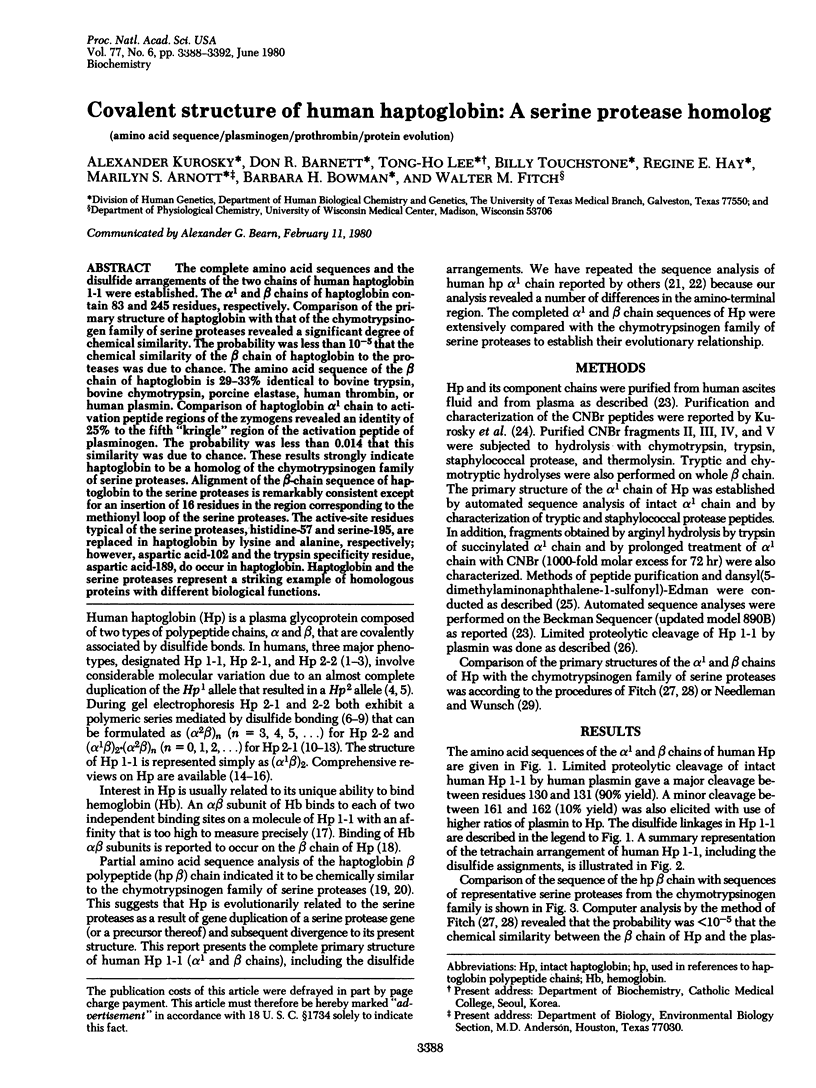
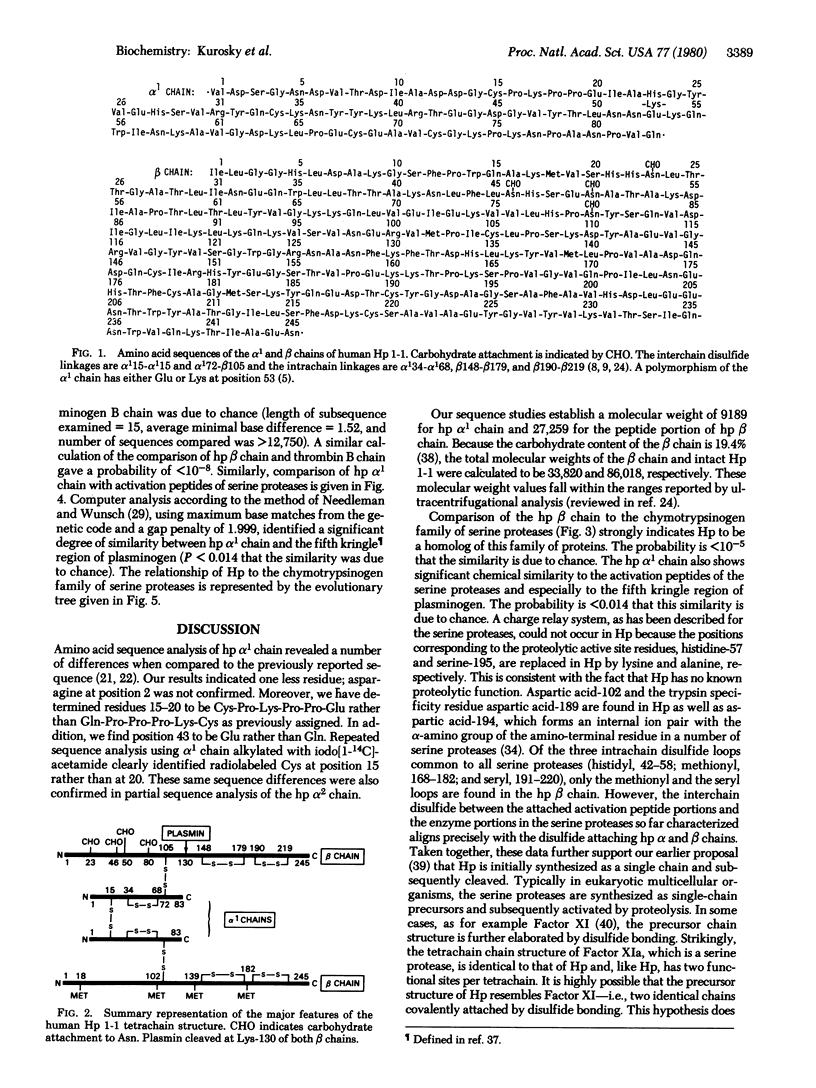
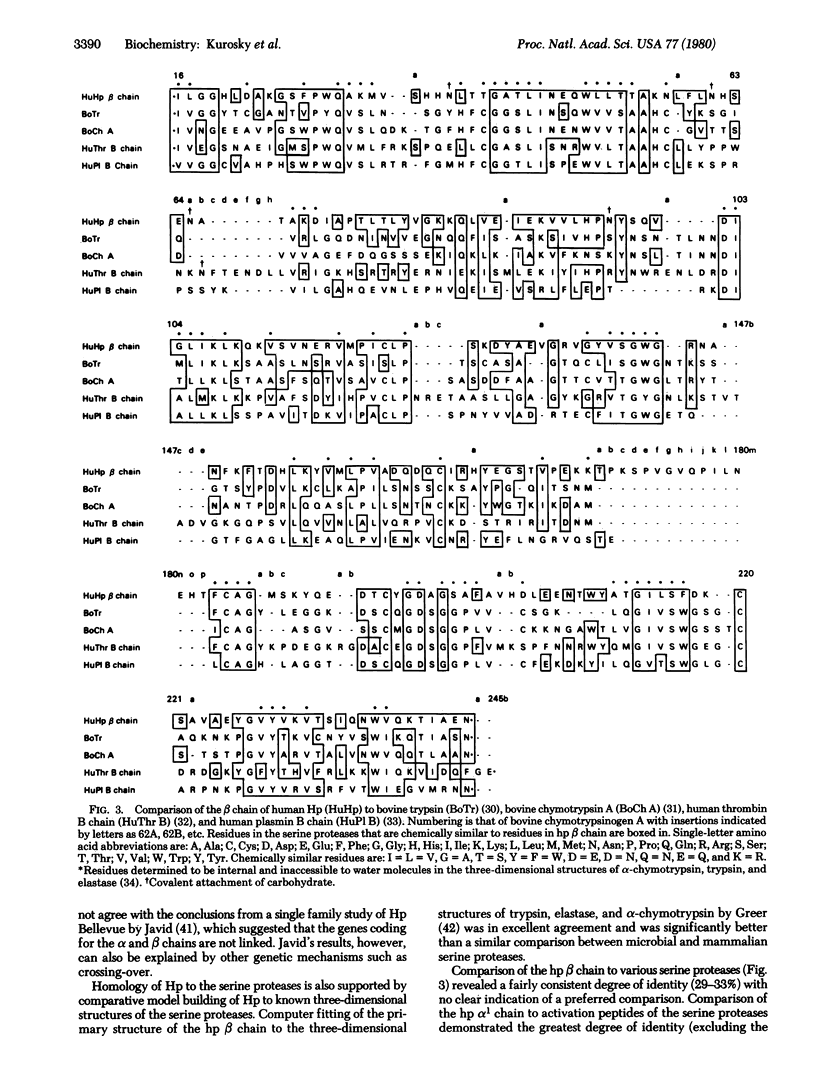
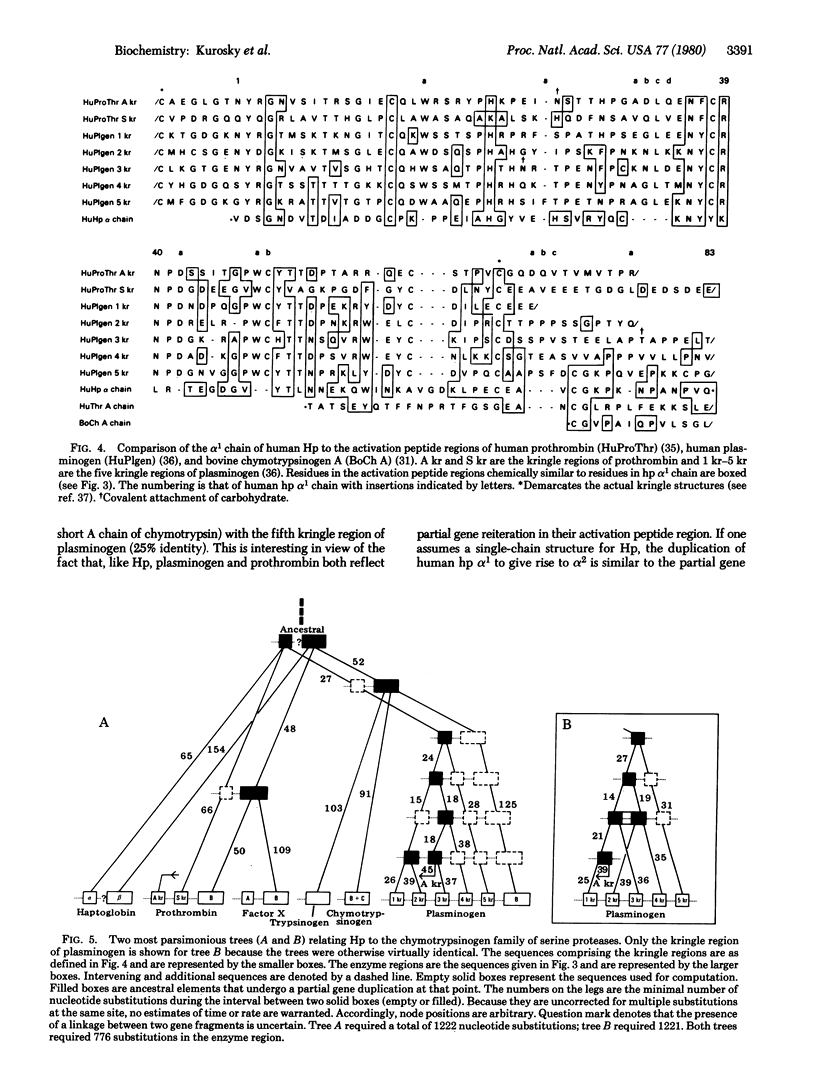
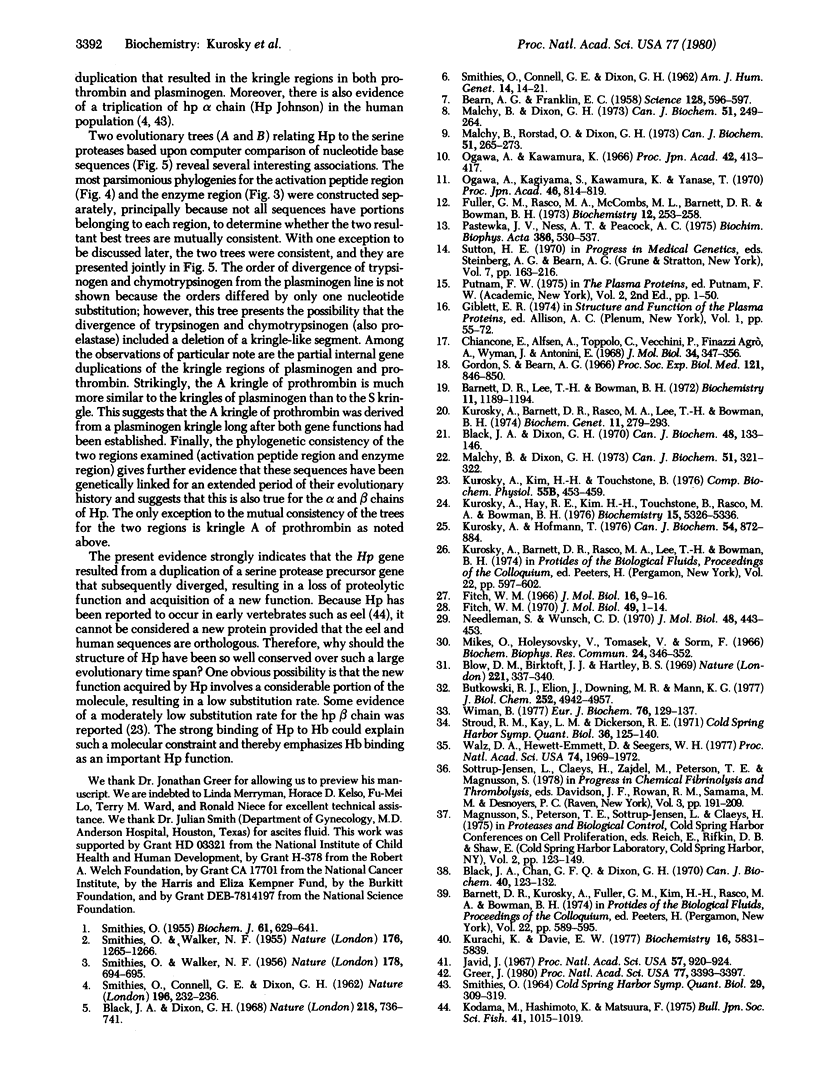
Selected References
These references are in PubMed. This may not be the complete list of references from this article.
- BEARN A. G., FRANKLIN E. C. Some genetical implications of physical studies of human haptoglobins. Science. 1958 Sep 12;128(3324):596–597. doi: 10.1126/science.128.3324.596. [DOI] [PubMed] [Google Scholar]
- Barnett D. R., Lee T. H., Bowman B. H. Amino acid sequence of the human haptoglobin beta chain. I. Amino- and carboxyl-terminal sequences. Biochemistry. 1972 Mar 28;11(7):1189–1194. doi: 10.1021/bi00757a012. [DOI] [PubMed] [Google Scholar]
- Black J. A., Chan G. F., Hew C. L., Dixon G. H. Gene action in the human haptoglobins. 3. Isolation of the alpha-chains as single gene products. Isolation, molecular weight, and amino acid composition of alpha and beta chains. Can J Biochem. 1970 Jan;48(1):123–132. doi: 10.1139/o70-019. [DOI] [PubMed] [Google Scholar]
- Black J. A., Dixon G. H. Amino-acid sequence of alpha chains of human haptoglobins. Nature. 1968 May 25;218(5143):736–741. doi: 10.1038/218736a0. [DOI] [PubMed] [Google Scholar]
- Black J. A., Dixon G. H. Gene action in the human haptoglobins. IV. Amino acid sequence studies on the haptoglobin alpha chains. Can J Biochem. 1970 Jan;48(1):133–146. doi: 10.1139/o70-020. [DOI] [PubMed] [Google Scholar]
- Blow D. M., Birktoft J. J., Hartley B. S. Role of a buried acid group in the mechanism of action of chymotrypsin. Nature. 1969 Jan 25;221(5178):337–340. doi: 10.1038/221337a0. [DOI] [PubMed] [Google Scholar]
- Butkowski R. J., Elion J., Downing M. R., Mann K. G. Primary structure of human prethrombin 2 and alpha-thrombin. J Biol Chem. 1977 Jul 25;252(14):4942–4957. [PubMed] [Google Scholar]
- Chiancone E., Alfsen A., Ioppolo C., Vecchini P., Agrò A. F., Wyman J., Antonini E. Studies on the reaction of haptoglobin with haemoglobin and haemoglobin chains. I. Stoichiometry and affinity. J Mol Biol. 1968 Jul 14;34(2):347–356. doi: 10.1016/0022-2836(68)90258-1. [DOI] [PubMed] [Google Scholar]
- Fitch W. M. An improved method of testing for evolutionary homology. J Mol Biol. 1966 Mar;16(1):9–16. doi: 10.1016/s0022-2836(66)80258-9. [DOI] [PubMed] [Google Scholar]
- Fitch W. M. Further improvements in the method of testing for evolutionary homology among proteins. J Mol Biol. 1970 Apr 14;49(1):1–14. doi: 10.1016/0022-2836(70)90372-4. [DOI] [PubMed] [Google Scholar]
- Fuller G. M., Rasco M. A., McCombs M. L., Barnett D. R., Bowman B. H. Subunit composition of haptoglobin 2-2 polymers. Biochemistry. 1973 Jan 16;12(2):253–258. doi: 10.1021/bi00726a012. [DOI] [PubMed] [Google Scholar]
- Gordon S., Bearn A. G. Hemoglobin binding capacity of isolated heptoglobin polypeptide chains. Proc Soc Exp Biol Med. 1966 Mar;121(3):846–850. doi: 10.3181/00379727-121-30905. [DOI] [PubMed] [Google Scholar]
- Greer J. Model for haptoglobin heavy chain based upon structural homology. Proc Natl Acad Sci U S A. 1980 Jun;77(6):3393–3397. doi: 10.1073/pnas.77.6.3393. [DOI] [PMC free article] [PubMed] [Google Scholar]
- Javid J. Haptoglobin 2-1 Bellevue, a haptoglobin beta-chain mutant. Proc Natl Acad Sci U S A. 1967 Apr;57(4):920–924. doi: 10.1073/pnas.57.4.920. [DOI] [PMC free article] [PubMed] [Google Scholar]
- Kurachi K., Davie E. W. Activation of human factor XI (plasma thromboplastin antecedent) by factor XIIa (activated Hageman factor). Biochemistry. 1977 Dec 27;16(26):5831–5839. doi: 10.1021/bi00645a030. [DOI] [PubMed] [Google Scholar]
- Kurosky A., Barnett D. R., Rasco M. A., Lee T. H., Bowman B. H. Evidence of homology between the beta-chain of human haptoglobin and the chymotrypsin family of serine proteases. Biochem Genet. 1974 Apr;11(4):279–293. doi: 10.1007/BF00485995. [DOI] [PubMed] [Google Scholar]
- Kurosky A., Hay R. E., Kim H., Touchstone B., Rasco M. A., Bowman B. H. Characterization of the cyanogen bromide fragments of the beta chain of human haptoglobin. Biochemistry. 1976 Nov 30;15(24):5326–5336. doi: 10.1021/bi00669a020. [DOI] [PubMed] [Google Scholar]
- Kurosky A., Hofmann T. Amino acid sequence of penicillopepsin. I. Isolation and characterization of the chymotryptic peptides. Can J Biochem. 1976 Oct;54(10):872–884. doi: 10.1139/o76-125. [DOI] [PubMed] [Google Scholar]
- Kurosky A., Kim H. H., Touchstone B. Comparative sequence analysis of the N-terminal region of rat, rabbit, and dog haptoglobin beta-chains. Comp Biochem Physiol B. 1976;55(3B):453–459. doi: 10.1016/0305-0491(76)90320-5. [DOI] [PubMed] [Google Scholar]
- Malchy B., Dixon G. H. Correction to the amino acid sequence of the chain of human haptoglobin. Can J Biochem. 1973 Mar;51(3):321–322. doi: 10.1139/o73-038. [DOI] [PubMed] [Google Scholar]
- Malchy B., Dixon G. H. Studies on the interchain disulfides of human haptoglobins. Can J Biochem. 1973 Mar;51(3):249–264. doi: 10.1139/o73-032. [DOI] [PubMed] [Google Scholar]
- Malchy B., Rorstad O., Dixon G. H. The half-molecule of haptoglobin: studies on the product obtained by the selective cleavage of a haptoglobin disulfide. Can J Biochem. 1973 Mar;51(3):265–273. doi: 10.1139/o73-033. [DOI] [PubMed] [Google Scholar]
- Mikes O., Holeysovský V., Tomásek V., Sorm F. Covalent structure of bovine trypsinogen. The position of the remaining amides. Biochem Biophys Res Commun. 1966 Aug 12;24(3):346–352. doi: 10.1016/0006-291x(66)90162-8. [DOI] [PubMed] [Google Scholar]
- Needleman S. B., Wunsch C. D. A general method applicable to the search for similarities in the amino acid sequence of two proteins. J Mol Biol. 1970 Mar;48(3):443–453. doi: 10.1016/0022-2836(70)90057-4. [DOI] [PubMed] [Google Scholar]
- Pastewka J. V., Ness A. T., Peacock A. C. Hemoglobin binding by isolated polymeric proteins from human haptoglobin types 2-1 and 2-2. Some suggested polymer subunit compositions. Biochim Biophys Acta. 1975 Apr 29;386(2):530–537. doi: 10.1016/0005-2795(75)90296-2. [DOI] [PubMed] [Google Scholar]
- SMITHIES O. CHROMOSOMAL REARRANGEMENTS AND PROTEIN STRUCTURE. Cold Spring Harb Symp Quant Biol. 1964;29:309–319. doi: 10.1101/sqb.1964.029.01.033. [DOI] [PubMed] [Google Scholar]
- SMITHIES O., CONNELL G. E., DIXON G. H. Chromosomal rearrangements and the evolution of haptoglobin genes. Nature. 1962 Oct 20;196:232–236. doi: 10.1038/196232a0. [DOI] [PubMed] [Google Scholar]
- SMITHIES O., CONNELL G. E., DIXON G. H. Inheritance of haptoglobin subtypes. Am J Hum Genet. 1962 Mar;14:14–21. [PMC free article] [PubMed] [Google Scholar]
- SMITHIES O., WALKER N. F. Genetic control of some serum proteins in normal humans. Nature. 1955 Dec 31;176(4496):1265–1266. doi: 10.1038/1761265a0. [DOI] [PubMed] [Google Scholar]
- SMITHIES O., WALKER N. F. Notation for serum-protein groups and the genes controlling their inheritance. Nature. 1956 Sep 29;178(4535):694–695. doi: 10.1038/178694a0. [DOI] [PubMed] [Google Scholar]
- SMITHIES O. Zone electrophoresis in starch gels: group variations in the serum proteins of normal human adults. Biochem J. 1955 Dec;61(4):629–641. doi: 10.1042/bj0610629. [DOI] [PMC free article] [PubMed] [Google Scholar]
- Stroud R. M., Kay L. M., Dickerson R. E. The crystal and molecular structure of DIP-inhibited bovine trypsin at2.7Angstrom resolution. Cold Spring Harb Symp Quant Biol. 1972;36:125–140. doi: 10.1101/sqb.1972.036.01.018. [DOI] [PubMed] [Google Scholar]
- Walz D. A., Hewett-Emmett D., Seegers W. H. Amino acid sequence of human prothrombin fragments 1 and 2. Proc Natl Acad Sci U S A. 1977 May;74(5):1969–1972. doi: 10.1073/pnas.74.5.1969. [DOI] [PMC free article] [PubMed] [Google Scholar]
- Wiman B. Primary structure of the B-chain of human plasmin. Eur J Biochem. 1977 Jun 1;76(1):129–137. doi: 10.1111/j.1432-1033.1977.tb11578.x. [DOI] [PubMed] [Google Scholar]


